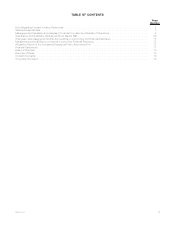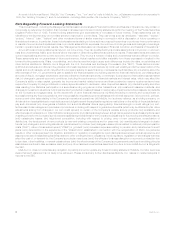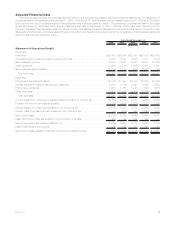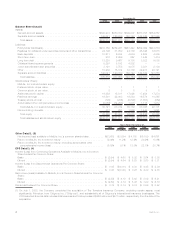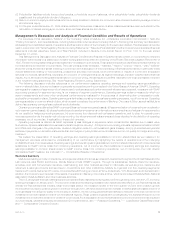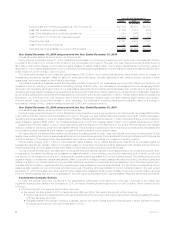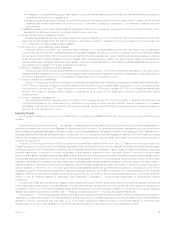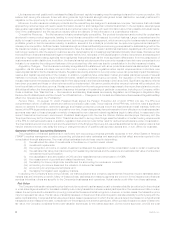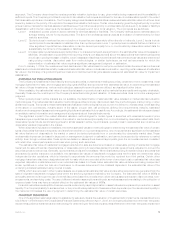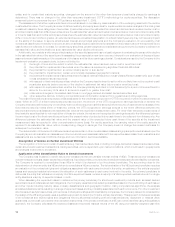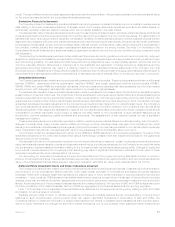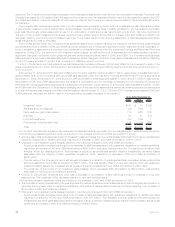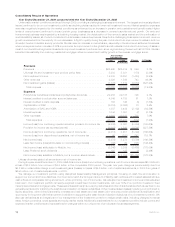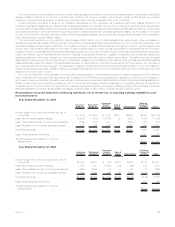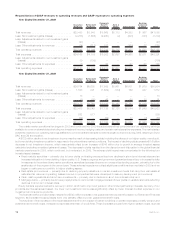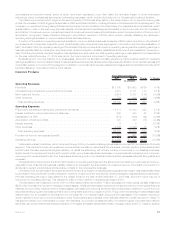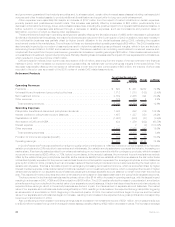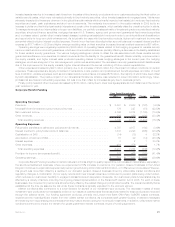MetLife 2009 Annual Report Download - page 17
Download and view the complete annual report
Please find page 17 of the 2009 MetLife annual report below. You can navigate through the pages in the report by either clicking on the pages listed below, or by using the keyword search tool below to find specific information within the annual report.model. The use of different methodologies, assumptions and inputs in the determination of the primary beneficiary could have a material effect
on the amounts presented within the consolidated financial statements.
Derivative Financial Instruments
The Company enters into freestanding derivative transactions including swaps, forwards, futures and option contracts to manage various
risks relating to its ongoing business operations. To a lesser extent, the Company uses credit derivatives, such as credit default swaps, to
synthetically replicate investment risks and returns which are not readily available in the cash market.
The estimated fair value of derivatives is determined through the use of quoted market prices for exchange-traded derivatives and financial
forwards to sell certain to be announced securities or through the use of pricing models for over-the-counter derivatives. The determination of
estimated fair value, when quoted market values are not available, is based on market standard valuation methodologies and inputs that are
assumed to be consistent with what other market participants would use when pricing the instruments. Derivative valuations can be affected
by changes in interest rates, foreign currency exchange rates, financial indices, credit spreads, default risk (including the counterparties to
the contract), volatility, liquidity and changes in estimates and assumptions used in the pricing models. See Note 5 of the Notes to the
Consolidated Financial Statements for additional details on significant inputs into the over-the-counter derivative pricing models and credit
risk adjustment.
The accounting for derivatives is complex and interpretations of the primary accounting guidance continue to evolve in practice. Judgment
is applied in determining the availability and application of hedge accounting designations and the appropriate accounting treatment under
such accounting guidance. If it was determined that hedge accounting designations were not appropriately applied, reported net income
could be materially affected. Differences in judgment as to the availability and application of hedge accounting designations and the
appropriate accounting treatment may result in a differing impact on the consolidated financial statements of the Company from that
previously reported. Assessments of hedge effectiveness and measurements of ineffectiveness of hedging relationships are also subject to
interpretations and estimations and different interpretations or estimates may have a material effect on the amount reported in net income.
Embedded Derivatives
The Company issues certain variable annuity products with guaranteed minimum benefits. These include guaranteed minimum withdrawal
benefits (“GMWB”), guaranteed minimum accumulation benefits (“GMAB”), and certain guaranteed minimum income benefits (“GMIB”).
GMWB, GMAB and certain GMIB are embedded derivatives, which are measured at estimated fair value separately from the host variable
annuity product, with changes in estimated fair value reported in net investment gains (losses).
The estimated fair values for these embedded derivatives are determined based on the present value of projected future benefits minus the
present value of projected future fees. The projections of future benefits and future fees require capital market and actuarial assumptions
including expectations concerning policyholder behavior. A risk neutral valuation methodology is used under which the cash flows from the
guarantees are projected under multiple capital market scenarios using observable risk free rates. Beginning in 2008, the valuation of these
embedded derivatives includes an adjustment for the Company’s own credit and risk margins for non-capital market inputs. The Company’s
own credit adjustment is determined taking into consideration publicly available information relating to the Company’s debt, as well as its
claims paying ability. Risk margins are established to capture the non-capital market risks of the instrument which represent the additional
compensation a market participant would require to assume the risks related to the uncertainties of such actuarial assumptions as
annuitization, premium persistency, partial withdrawal and surrenders. The establishment of risk margins requires the use of significant
management judgment.
These guarantees may be more costly than expected in volatile or declining equity markets. Market conditions including, but not limited to,
changes in interest rates, equity indices, market volatility and foreign currency exchange rates; changes in the Company’s own credit
standing; and variations in actuarial assumptions regarding policyholder behavior, and risk margins related to non-capital market inputs may
result in significant fluctuations in the estimated fair value of the guarantees that could materially affect net income.
The Company ceded the risk associated with certain of the GMIB and GMAB described in the preceding paragraphs. The value of the
embedded derivatives on the ceded risk is determined using a methodology consistent with that described previously for the guarantees
directly written by the Company.
The estimated fair value of the embedded equity and bond indexed derivatives contained in certain funding agreements is determined
using market standard swap valuation models and observable market inputs, including an adjustment for the Company’s own credit that takes
into consideration publicly available information relating to the Company’s debt, as well as its claims paying ability. Changes in equity and
bond indices, interest rates and the Company’s credit standing may result in significant fluctuations in estimated the fair value of these
embedded derivatives that could materially affect net income.
The accounting for embedded derivatives is complex and interpretations of the primary accounting standards continue to evolve in
practice. If interpretations change, there is a risk that features previously not bifurcated may require bifurcation and reporting at estimated fair
value in the consolidated financial statements and respective changes in estimated fair value could materially affect net income.
Deferred Policy Acquisition Costs and Value of Business Acquired
The Company incurs significant costs in connection with acquiring new and renewal insurance business. Costs that vary with and relate to
the production of new business are deferred as DAC. Such costs consist principally of commissions and agency and policy issuance
expenses. VOBA is an intangible asset that represents the present value of future profits embedded in acquired insurance annuity and
investment — type contracts. VOBA is based on actuarially determined projections, by each block of business, of future policy and contract
charges, premiums, mortality and morbidity, separate account performance, surrenders, operating expenses, investment returns and other
factors. Actual experience on the purchased business may vary from these projections. The recovery of DAC and VOBA is dependent upon
the future profitability of the related business. DAC and VOBA are aggregated in the financial statements for reporting purposes.
Note 1 of the Notes to the Consolidated Financial Statements describes the Company’s accounting policy relating to DAC and VOBA
amortization for various types of contracts.
Separate account rates of return on variable universal life contracts and variable deferred annuity contracts affect in-force account
balances on such contracts each reporting period which can result in significant fluctuations in amortization of DAC and VOBA. The
Company’s practice to determine the impact of gross profits resulting from returns on separate accounts assumes that long-term appre-
ciation in equity markets is not changed by short-term market fluctuations, but is only changed when sustained interim deviations are
11MetLife, Inc.


